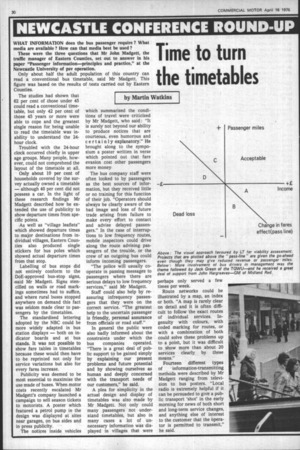Time to turn
Page 32

If you've noticed an error in this article please click here to report it so we can fix it.
the timetables
by Martin Watkins
WHAT INFORMATION does the bus passenger require ? What media are available ? How can that media best be used ?
These were the three questions that Mr John Madgett, the traffic manager of Eastern Counties, set out to answer in his paper "Passenger information—principles and practice," at the Newcastle University of psv operation.
Only about half the adult population of this country can read a conventional bus timetable, said Mr Madgett. This figure was based on the results of tests carried out by Eastern Counties.
The studies had shown that 62 per cent of .those under 45 could read a conventional timetable, but only 42 per cent of those 45 years or more were able to cope and the greatest single reason for being unable to read the timetable was inability to understand the 24hour clock.
Troubled with the 24-hour clock occurred chiefly in upper age groups. Many people, however, could not comprehend the layout of the timetable at all.
Only about 10 per cent of households covered by the survey actually owned a timetable — although 40 per cent did not possess a car. In the light of these research findings Mr Madgett described how he extended the use of publicity to show departure times from specific points.
As well as "village leaflets" which showed departure times to major destinations from individual villages, Eastern Counties also produced single stickers for bus poles which showed actual departure times from that stop.
Labelling of bus stops did not entirely conform to the DoE-approved bus-stop signs, ,said Mr Madgett. Signs stencilled on walls or road markings sometimes had to suffice, and where rural buses stopped anywhere on demand this fact was seldom made clear to passengers by the timetables.
The standardised lettering adopted by the NBC could be more widely adapted in bus station displays — both on indicator boards and at bus stands. It was not possible to show fare tables in 'timetables because these would then have to be reprinted not only for service variations but also for every fares increase.
Publicity was deemed to be most essential to maximise the use made of buses. When motor costs recently escalated Mr Madgett's company launched a campaign to sell season tickets to motorists. A poster which featured a petrol pump in the design was displayed at sites near garages, on bus sides and in press publicity.
The notices inside vehicles which summarised the conditions of travel were criticised by Mr Madgett, who said : "It is surely not beyond our ability to produce notices that are courteous, even humorous and certainly explanatory." He brought along to the symposium a poster written in verse which pointed out that fare evasion cost other passengers more money.
The bus company staff were often looked to by passengers as the best sources of information, but they received little or no training for this function of their job. "Operators should always be clearly aware of the bad image and loss of future trade arising from failure to make every effort to contact and advise delayed passengers." In the case of interruptions to low frequency routes, mobile inspectors could drive along the route advising passengers of the trouble, or the crew of an outgoing bus could inform incoming passengers.
"The police will usually cooperate in passing messages to passengers where there are serious delays to low frequency services," said Mr Madgett.
Staff could also help by reassuring infrequency passengers that they were on the correct service. "The greatest help to the uncertain passenger is friendly, personal assurance from officials or road staff."
In general the public were also badly informed about the constraints under which the bus companies operated. "There is a great deal of public support to be gained simply by explaining our present problems and future potential and by showing ourselves as human and deeply concerned with the transport needs of our customers," he said.
A plea for simplicity in the actual design and display of timetables was also made by Mr Madgett. Not only could many passengers not understand timetables, but also in many cases a lot of unnecessary information was displayed in villages that were perhaps only served a few times per week.
Route networks could be illustrated by a map, an index or both. "A map is rarely clear on detail and it is often difficult to follow the exact routes of individual services. Ingenuity with colours, with coded marking for routes, or with a combination of both could solve these problems up to a point, but it was difficult to show more than about 20 services clearly by these means."
Fourteen different types of information-transmitting methods were described by Mr Madgett ranging from television to bus posters. 'Local radio is extremely helpful if it can be persuaded to give a public transport 'shot' in the early morning for news of both short and long-term service changes, and anything else of interest to the customer that the operator is permitted to transmit," he said.




























































































